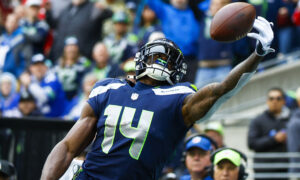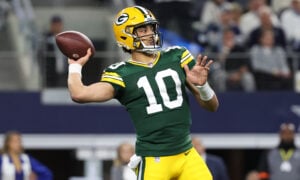Off-Season Mock Drafts: Rookie Tier Movement
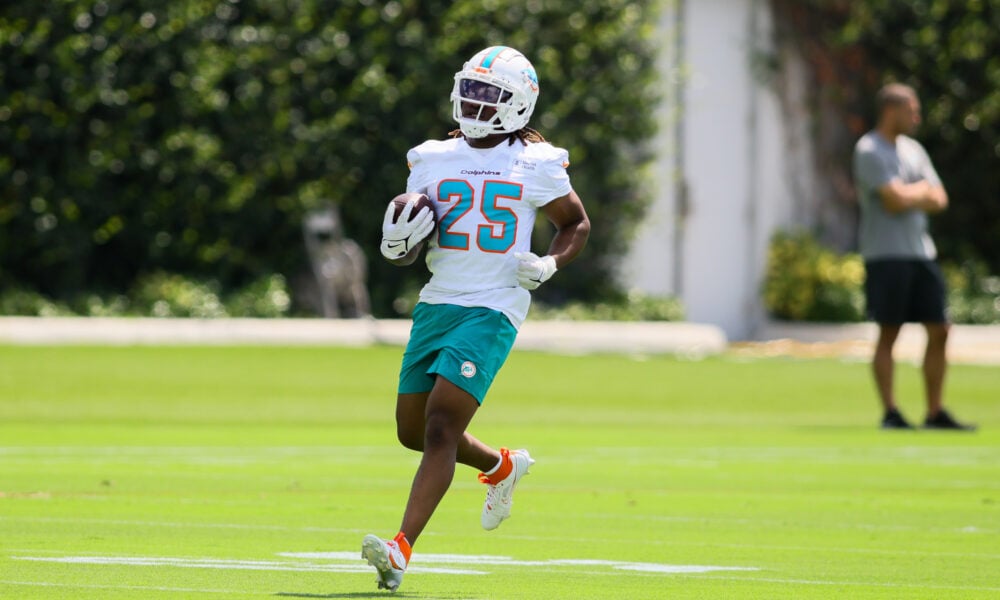
This year’s rookie class has a clear top two quarterbacks, a clear top two running backs, a clear top three at receiver, and a clear top tight end that have held those spots since rookie mocks began back in February. Looking back over the last five months, I used DLF’s ADP comparison tool to see where the movement has been once we get past the top of each position group. This will also be useful if you still have upcoming rookie drafts, as you’ll be able to see the tiers players have been broken into based on five months of ADP data.
Quarterbacks

Since the mocks began, Caleb Williams and Jayden Daniels have been the top two QBs. Once we get to the remaining quarterbacks, we have seen some movement. Initially, JJ McCarthy was well behind Drake Maye; however, in the last month, McCarthy has supplanted Maye as the QB3. Bo Nix has been another riser at the position. In March, he was QB7 behind even Spencer Rattler; now, Nix is the clear QB5. Michael Penix‘s ADP has been on a bit of a roller coaster ride, and rightfully so. He is the least likely of the top six to start any games over the next three years, but he’s probably the most likely to start games in 2027.
Tier 2 Running Backs
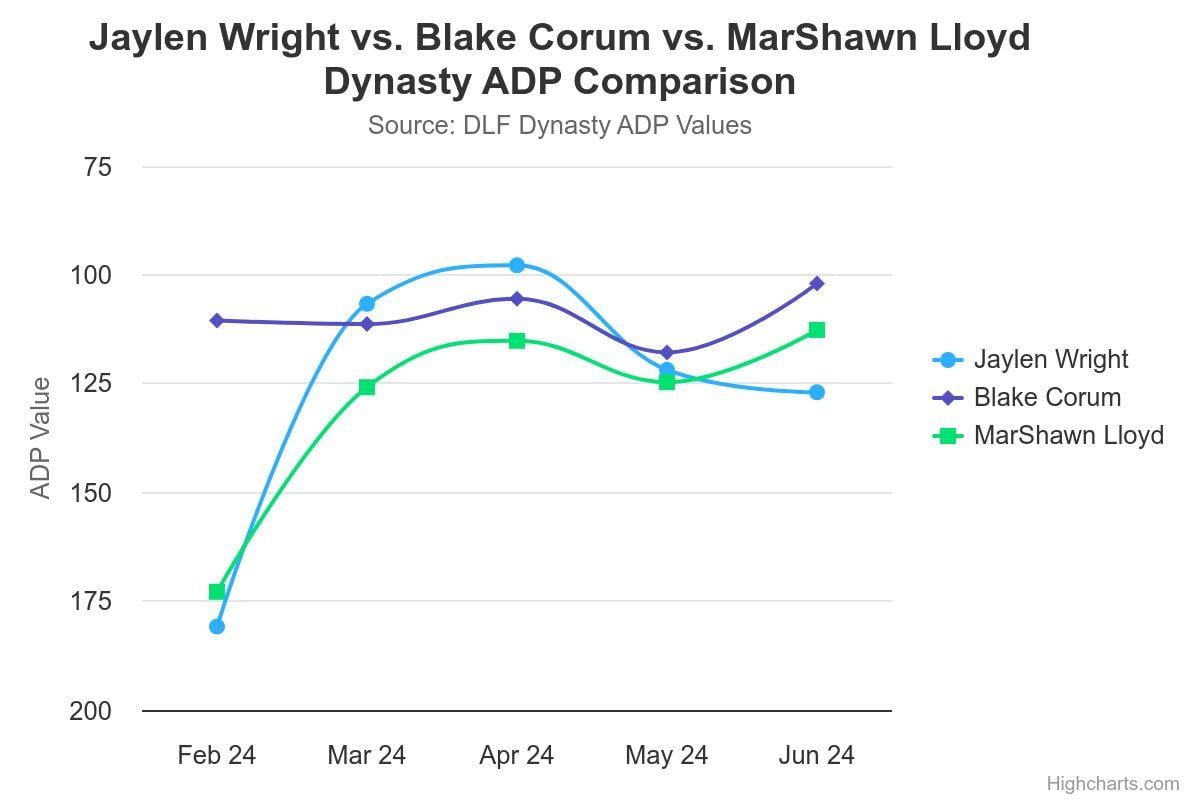
Once Jonathon Brooks and Trey Benson are off the board, we’ve got a “next three” at the running back position. Blake Corum was the clear RB3 back in February, and then we saw him dip to RB4 for a couple of months. Then, despite his startup ADP dropping in May, he regained his RB3 status and has held it since.
Jaylen Wright was totally off people’s radar back in February, and he saw a considerable ADP jump through March and April, climbing to RB3, but has dipped again in the last two months, falling to RB4 and now back to RB5 as of June. I have seen MarShawn Lloyd creeping up more and more in recent drafts, but I had no idea that he has gotten to RB4 and is nipping at Corum’s heels for the RB3 spot.
Tier 3 Running Backs

This tier of backs has seen a lot of significant movement. In February, Braelon Allen and Bucky Irving were within ten places of Blake Corum. Allen, in particular, has seen a significant fall since then and is now the RB11 after landing behind Breece Hall in New York. Irving, although falling in ADP, has floated in that RB7-to-RB8 range regardless of his ADP drop.
Ray Davis has been trending upwards since February, even becoming the top option in this tier at one point, but now he is behind both Kimani Vidal and Irving as the RB8. Vidal has seen a tremendous rise in ADP, as he was essentially off the radar through February, March, and April. As of June, he has become the top option in tier three, jumping ahead of everyone else in this range. Tyrone Tracy Jr paralleled Vidal’s rise from obscurity, while Audric Estime‘s ADP has remained relatively steady over the last five months.
Tier 4 Running Backs

I find tier four especially interesting. If we see significant injuries to Saquon Barkley, Christian McCaffrey, Zamir White, and Derrick Henry, there is a path for everyone in tier four to flirt with a potential top-15 finish at the position. You really can’t say that about anyone in tier three. Isaac Guerendo and Rasheen Ali were complete unknowns to many, which was reflected in their ADP through April. That is no longer the case, as Guerendo climbed to second among this group in May, and Ali is now the top option in tier four.
In the case of Will Shipley and Dylan Laube, slow and steady wins the race. Although Shipley’s ADP peaked in April, his ADP between February and June has been relatively flat. On the other hand, Laube has never really “peaked” despite a slow, steady rise in his ADP, despite him probably being the most likely to have a usable role in PPR scoring leagues starting in week one.
Tier 2 Wide Receivers

Everyone knows the long-established top three at the position: Marvin Harrison Jr, Malik Nabers, and Rome Odunze. We now have a clear four-person second tier as drafts have played out, although they’ve taken different paths to get here. Propelled by a record-setting 40-yard dash time and a premium landing spot in Kansas City, Xavier Worthy climbed from February’s WR7 to the clear WR4 now.
Despite finding himself as the potential WR1 in a Josh Allen-led Bills’ offense, Keon Coleman has seen minimal movement. He was rookie WR6 in February and is still rookie WR6, despite his startup ADP climbing from 83 to 58. Brian Thomas also has been relatively flat, only climbing from 65th to 52nd in startup ADP. Charger receiver Ladd McConkey rounds out this quartet. He was rookie WR9 in February but has charged (no pun intended) up the boards and was as high as WR5 in this class last month.
Tier 3 Wide Receivers
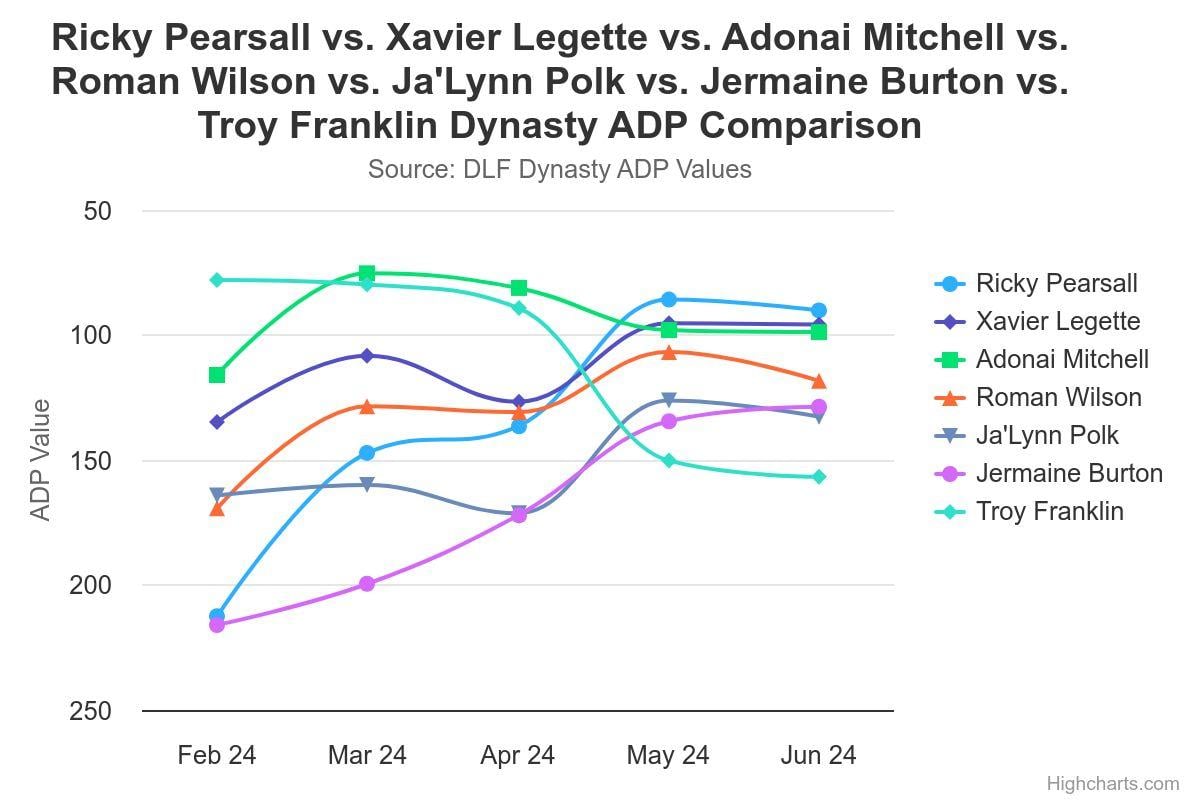
I’ve been talking about this all off-season, but no matter how many articles I’ve written or how many drafts I’ve participated in, I still can’t get over how deep this receiver class is, as tier three is still stacked with talent.
After receiving first-round draft capital from the 49ers, Ricky Pearsall has skyrocketed up draft boards. He had an ADP of 212 in February startups and is now going 90th overall, moving from rookie WR17 to WR8. Jermaine Burton has also been climbing; as dynasty owners come to grips with the potential departure of Cincinnati’s Tee Higgins, Burton could have one of the best roles of any sophomore receiver a year from now.
Xavier Legette, Roman Wilson, and Ja’Lynn Polk had a similar dip in April, followed by a bump in May and June. Adonai Mitchell went the opposite way a bit, with a slight bump in March and April while falling in May and June. At the same time, Troy Franklin has been one of the biggest losers so far. As WR5 in February, he has seen his stock plummet since then and is the current rookie WR14. I think he would still be falling had he not landed in Denver alongside his college QB, Bo Nix.
Tier 4 Wide Receivers

Within the next two or three years, every one of these guys could be their team’s WR2. Malachi Corley, Luke McCaffrey, and Malik Washington saw a similar ADP arc, peaking in May, although McCaffrey’s rise was slightly more pronounced. Javon Baker and Jalen McMillan have fun ADP paths to compare. When one has gone up, the other has come down, and vice versa. I’m unsure what to take away from that, except maybe dynasty managers can be a fickle bunch sometimes.
Tier 5 Wide Receivers
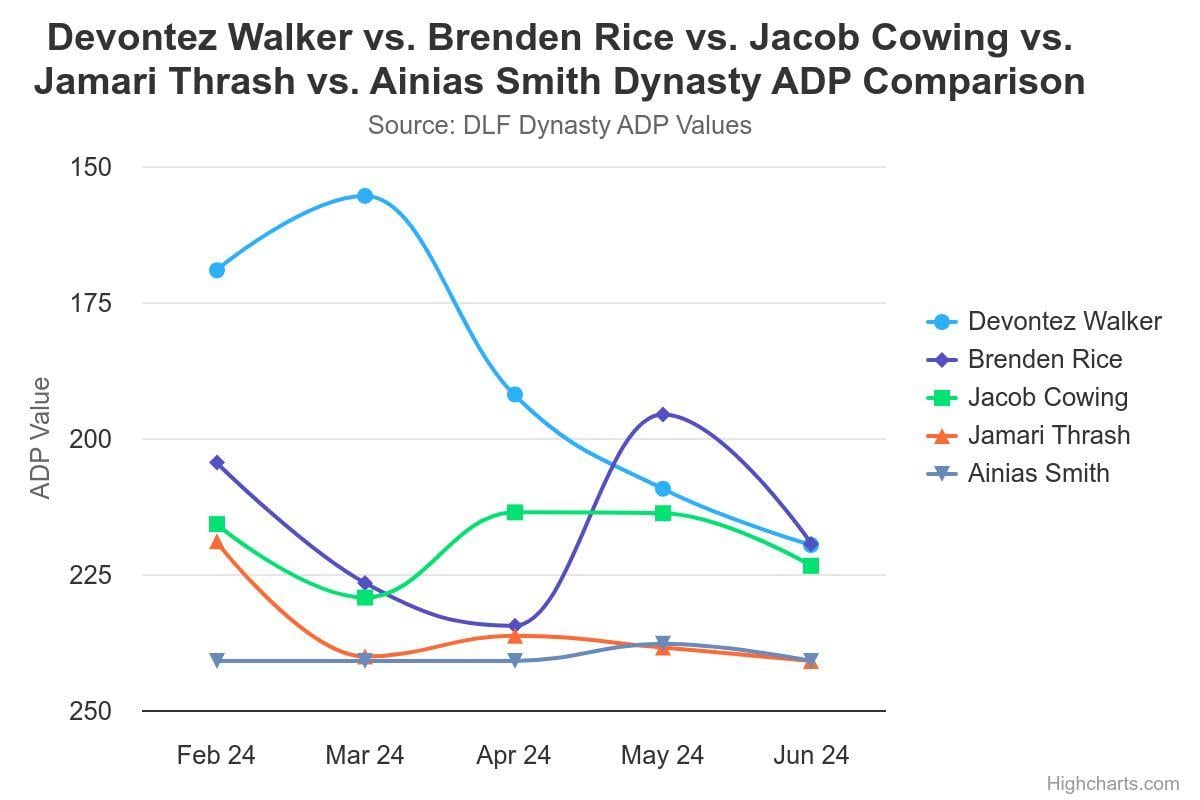
Tier five’s Devontez Walker is the only player giving Troy Franklin a run for his money as the biggest faller. Franklin dropped 78 spots in startup ADP since February, but Walker has fallen 50 spots himself. The combination of a bad week of practice at the Senior Bowl, a less-than-ideal showing at the combine, and a nightmare landing spot in Baltimore are all contributing factors. Jerry Rice’s son saw the same May bump most of tier four saw, but he’s returned to earth a bit this month. Some people had a fleeting interest in Jamari Thrash in February, but he seems to be off people’s radar now. In comparison, Ainias Smith has never really been on anyone’s radar.
Tight Ends
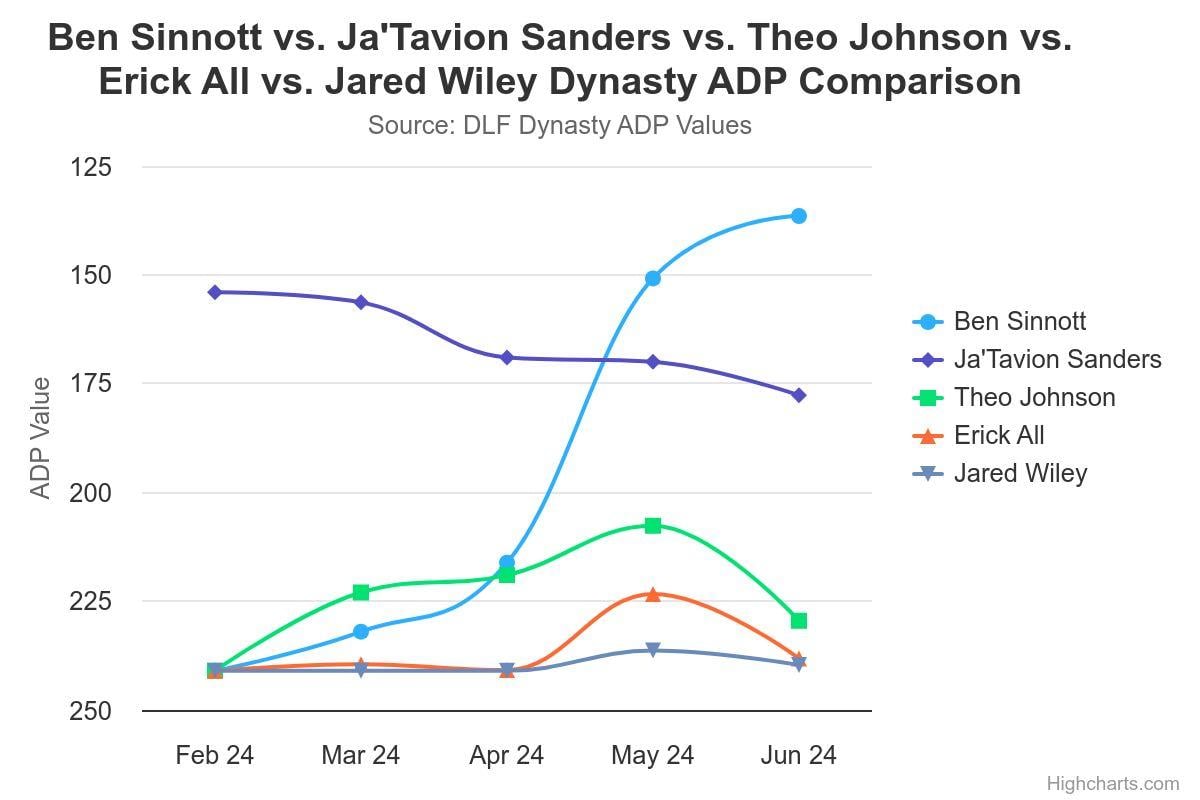
Brock Bowers is TE1 and has been since last year, maybe even since 2022. So now what? Ben Sinnott has come from nowhere to lock himself in as the clear TE2 this year among rookies. Ja’Tavion Sanders has trailed off a bit month by month in startup ADP but is still head and shoulders ahead of the rest of this year’s class.
The Biggest shocker to me is that Theo Johnson trended up for four months but mysteriously dropped a bit in June. I suspect his July ADP bounces back now that Darren Waller is calling it a career. Erick All and Jared Wiley are the final draft-worthy options, and both are dirt-cheap options with significant long-term potential on their respective teams.
Although the tippy-top of this year’s class at each position hasn’t changed at all during the off-season, we have seen some significant movement outside of the top tier. A few players have moved between tiers, but for the most part, even this year’s tiers remained relatively steady, with most of the moving and shaking happening within the tiers themselves. Keep these tiers and the movement trends in mind if you’ve got drafts to complete over the next few months. In the event your drafts are all done, you might be able to use their prior and current ADP information to work a trade, as player perception seems to have shifted quite a bit on several players over the last five months.
- Off-Season Mock Drafts: Rookie Tier Movement - June 22, 2024
- Off-Season Mock Drafts: Single QB Start-Up Results - June 15, 2024
- Examining Return Specialists in Your Dynasty Leagues - June 8, 2024





